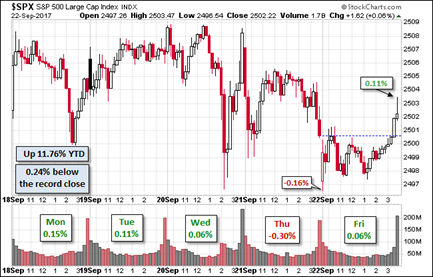With the FOMC decision behind us and a moderate data calendar, the financial world will be focused on Washington. Expect people to be asking:
Has the time come for tax reform?
Last Week Recap
My expectation for last week was partly correct. The focus was certainly on the Fed, but the market reacted quite calmly.
The Story in One Chart
I always start my personal review of the week by looking at this great chart from Doug Short via Jill Mislinski. There was little change on the week, and little change during the week. The range was only 50 bps even during the Wednesday Fed announcement.

Doug has a special knack for pulling together all the relevant information. His charts save more than a thousand words. Read the entire post for several more charts providing long-term perspective, including the size and frequency of drawdowns.
Personal Note
My plans changed, so I was able to write today. I’ll get a weekend off soon.
The Silver Bullet
As I indicated recently I am moving the Silver Bullet award to a standalone feature, rather than an item in WTWA. I hope that readers and past winners, listed here, will help me in giving special recognition to those who help to keep data honest. As always, nominations are welcome.
The News
Each week I break down events into good and bad. For our purposes, “good†has two components. The news must be market friendly and better than expectations. I avoid using my personal preferences in evaluating news – and you should, too.
The economic news remained quite positive.
The Good
- Fed decision led to little market reaction. I am scoring this as “good†because no one expected a statement that was friendly for stocks. The actual announcement was a bit more hawkish than most expected, but the market reaction was muted. Perhaps the Fed obsession will take a back seat and we can focus on earnings. Scott Grannis calls the decision “cautious and correct.â€Â Eddy Elfenbein is a bit less sanguine.
- Corporate earnings outlook is even better. FactSet reports that “a record number of S&P companies have issued positive revenue guidance for Q3â€. Information Technology, Health Care, and Consumer Discretionary have been especially strong.
- Leading indicators increased 0.4% up from 0.3% in July. (Conference Board).
- Trucking continues to improve. Steven Hansen (GEI) explains why we should emphasize the CASS index and notes that the improvement remains “moderate.â€
- Jobless claims had a surprising decline in the face of hurricane effects. Will it continue? Bespoke has the story and one of their great charts.

- Housing starts and building permits beat expectations. Calculated Risk notes that the 0.8% decline compared to an upwardly revised July actually beat expectations. He has correctly forecast and monitored the shift from multi-family to single-family starts, concluding “now I expect a few years of increasing single family starts and completions. Permits beat expectations with a 1.3 million rate. Contra – New Deal Democrat notes that we have not yet seen the hurricane effect.

Bespoke’s take on permits:

The Bad
- Existing home sales declined 1.7% in August. Calculated Risk is not very concerned, citing low inventory. He does note that hurricane effects are still to come.Â
-
Escalation in the war of words with “Rocket Man,†“dotard,†and aggressive threats. A key to the story is the situation of South Korea.Brookings has a great background article by Kathy Moon, a Senior Fellow and Professor at Wellesley.
For the United States, a nuclear armed North Korea undercuts its security and traditional policy objectives, such as nonproliferation, and destabilizes the East Asia region. But for South Korea, it is an existential threat. Given the high tensions of late, Seoul fears being dragged into a war or, at the very least, falling victim to limited military exchanges between Washington and Pyongyang.
- Rail traffic declined. This is especially true when using Steven Hansen’s“intuitive sectors†which remove coal and grain from the analysis.
- Builder confidence decreased to 64 from a revised 67 in August. Calculated Risk notes that this is “a solid reading.â€Â Mortgage applications were also down 9.7% from the week before.

